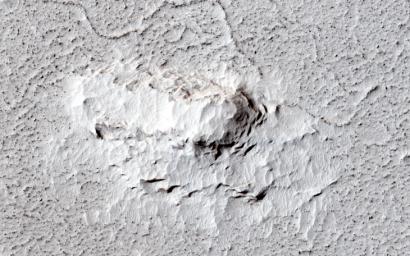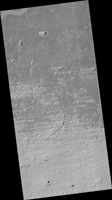
|
Which Came First, the Yardang or the Platy Flow?
- Click the image above for a larger view
- Full-Res JPEG (2880 x 1800) (895.9 kB)
- Full-Res TIFF (2880 x 1800) (15.6 MB)
Caption:

Map Projected Browse Image
Click on the image for larger version
One of the great strengths of HiRISE is that its high resolution can help resolve interesting questions: in this observation, is the platy flow material younger than the yardang-forming material?
A "yardang" is a streamlined hill made of loose rock and bedrock that's been shaped by wind erosion. The volcanic platy flow material in the same area should be older than the yardang material. The purpose of this observation is to figure out whether the platy flow materials trap or catch (embay) the yardang-forming material, or are just covered by that material.
Background Info:
HiRISE is one of six instruments on NASA's Mars Reconnaissance Orbiter. The University of Arizona, Tucson, operates the orbiter's HiRISE camera, which was built by Ball Aerospace & Technologies Corp., Boulder, Colo. NASA's Jet Propulsion Laboratory, a division of the California Institute of Technology in Pasadena, manages the Mars Reconnaissance Orbiter Project for the NASA Science Mission Directorate, Washington.
Cataloging Keywords:
| Name | Value | Additional Values |
|---|---|---|
| Target | Mars | |
| System | ||
| Target Type | Planet | |
| Mission | Mars Reconnaissance Orbiter (MRO) | |
| Instrument Host | Mars Reconnaissance Orbiter | |
| Host Type | Orbiter | |
| Instrument | High Resolution Imaging Science Experiment (HiRISE) | |
| Detector | ||
| Extra Keywords | Color, Map, Volcano | |
| Acquisition Date | ||
| Release Date | 2014-02-13 | |
| Date in Caption | ||
| Image Credit | NASA/JPL-Caltech/Univ. of Arizona | |
| Source | photojournal.jpl.nasa.gov/catalog/PIA17982 | |
| Identifier | PIA17982 | |
